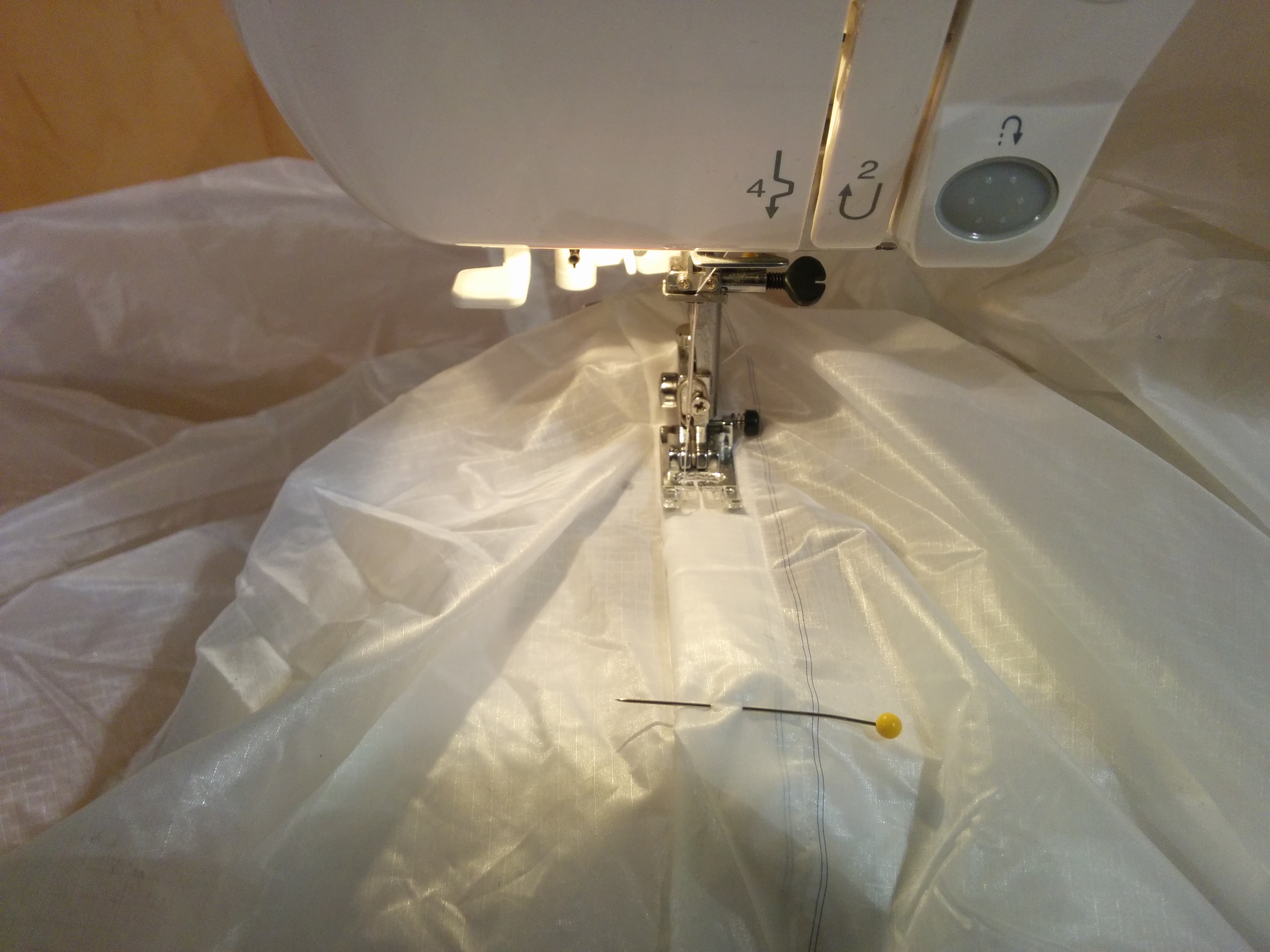Complete Camping Hammock With Screen and Rainfly
by adamtylernelson in Outside > Camping
69367 Views, 1051 Favorites, 0 Comments
Complete Camping Hammock With Screen and Rainfly




This project will show you step-by-step how to make a complete camping hammock, including the hammock, mesh bugnet, rainfly, and tree straps. I built this as a gift for for my girlfriend, who loves borrowing the Hennessy Hammock I've had since I was a Boy Scout, and is taking longer and longer to give it back each time....
All told, this project took me about two full days of work, with estimated materials costs of about $100.
Research and Design


From what I've seen, there are two basic camping hammock designs - attached bugnets (like the Hennessy) and unattached (like the Eno). I own a Hennessy and like it, but building one (even with guides like these) seemed intimidating, and there are a few improvements that I wanted to make to the rainfly design anyway. The Eno, by comparison, has a simpler and more flexible design that I could add to and modify - much better for a first attempt. With that in mind, the final hammock camping system has four components:
- a basic nylon basehammock with a ridgeline,
- a mesh and nylon sleeve that serves as a bugnet,
- a very large rainfly with a separate suspension, and
- daisy chain-style hanging straps.
This project builds on the work of two others here on Instructables, which I'll link to again at the appropriate stages of the project:
Make a Rip-Stop Nylon Hammock by Mrballeng.
DIY Hammock Straps by ralema69.
I also got a lot of great information and inspiration from Just Jeff's Hammock Camping Page.
Materials
To build a complete system, you will need:
Materials:
- 10'x5' ripstop nylon for the base hammock
- 8'x5' ripstop nylon for the sleeve
- 8'x6' mesh netting for the sleeve
- 12'x5' + 12'x2.5' ripstop nylon for the rainfly
- 1.5'x3' scrap nylon for the bag
- ~10' tubular webbing
- ~150' paracord (I used 3 different colors)
- 8" pipe insulation
- strong thread
- 4 tent stakes
- Wash-in waterproofing (e.g. Nikwax)
- 2 climbing carabiners
I used three different colors of nylon (what I had on hand), and three different colors/strengths of paracord (for a combination of aesthetic and safety reasons).
Tools:
- Sharp fabric scissors
- Iron
- Sewing machine and needles
- lighter or blowtorch for fusing rope ends
I built this at Techshop using a Janome home sewing machine, and no special equipment was required. However, if you had a rolling hem presser foot, a LOT of work could probably be avoided.
The Base Hammock








I built a basic hammock by following the instructions outlined in this project: https://www.instructables.com/id/Make-a-Rip-Stop-Ny...
There were only a couple differences between Mrballeng's project and mine - I didn't double-layer the cloth (didn't feel it was necessary), and I whipped the paracord at the end to create a cleaner loop. I also attached a ridgeline to the inner part of the paracord loops.
Make Hammock Straps


I made hammock hanging straps following the instructions here: https://www.instructables.com/id/DIY-Hammock-Straps.... I used about 10'-12' of rope to make a 5'-6' chain.
After some experimentation, I've found that the rope chain method isn't versatile enough. I've created new tree hugger straps out of 5' of 1" webbing, with simple overhand knots to create loops at both ends, and a length of ~15' of paracord running from the hammock loops, to be secured with a tensioning knot like a rolling hitch or a truckers hitch.
Cut the Nylon and Mesh for the Sleeve



Cut the ripstop nylon and mesh for the sleeve:
- 1'x8' nylon with a 1" pocket for the top
- 6'x8' mesh for the middle
- 4'x8' nylon with a 1" pocket for the bottom
Sew the Three Pieces of the Sleeve Together







Pin and sew the three pieces of the sleeve to one another. Sew each seam three times:
- Straight stitch about 1" from the fabric edge to create a straight seam.
- Zig-zag stitch between the first seam and the edge to securely bind the mesh and nylon.
- Separate the pieces and sew the seam flat.
Complete the Sleeve









Fold the sleeve fabric in half (seams out) to create a 12'x4' nylon-mesh-nylon sleeve. Sew along the edge to create a tube of fabric, then turn the sleeve inside out and thread paracord through each pocket to create a loop. You'll use these loops of paracord to cinch the ends shut, creating a bug-free sleeping area.
Cut, Sew, Hem, and Seal the Rainfly








To make a rainfly wide enough, I sewed a 5' and 2.5' wide pieces together. This creates an offset seam (didn't want the seam directly above the hammock for fear of leaking). I then hemmed the whole thing, and added 2" loops of webbing to the corners. Cut a length of paracord 20'-25' for the fly suspension, and wash the whole thing in weatherproofing fluid.
For the guy-lines, check out these knot resources:
Give


Give the completed hammock to a very special person, and set a date for a backcountry trip for two.
This Instructable is part of the "Homemade Gifts" contest, so if you like it please vote for it!
Hang Out.










Hang the hammock and enjoy!